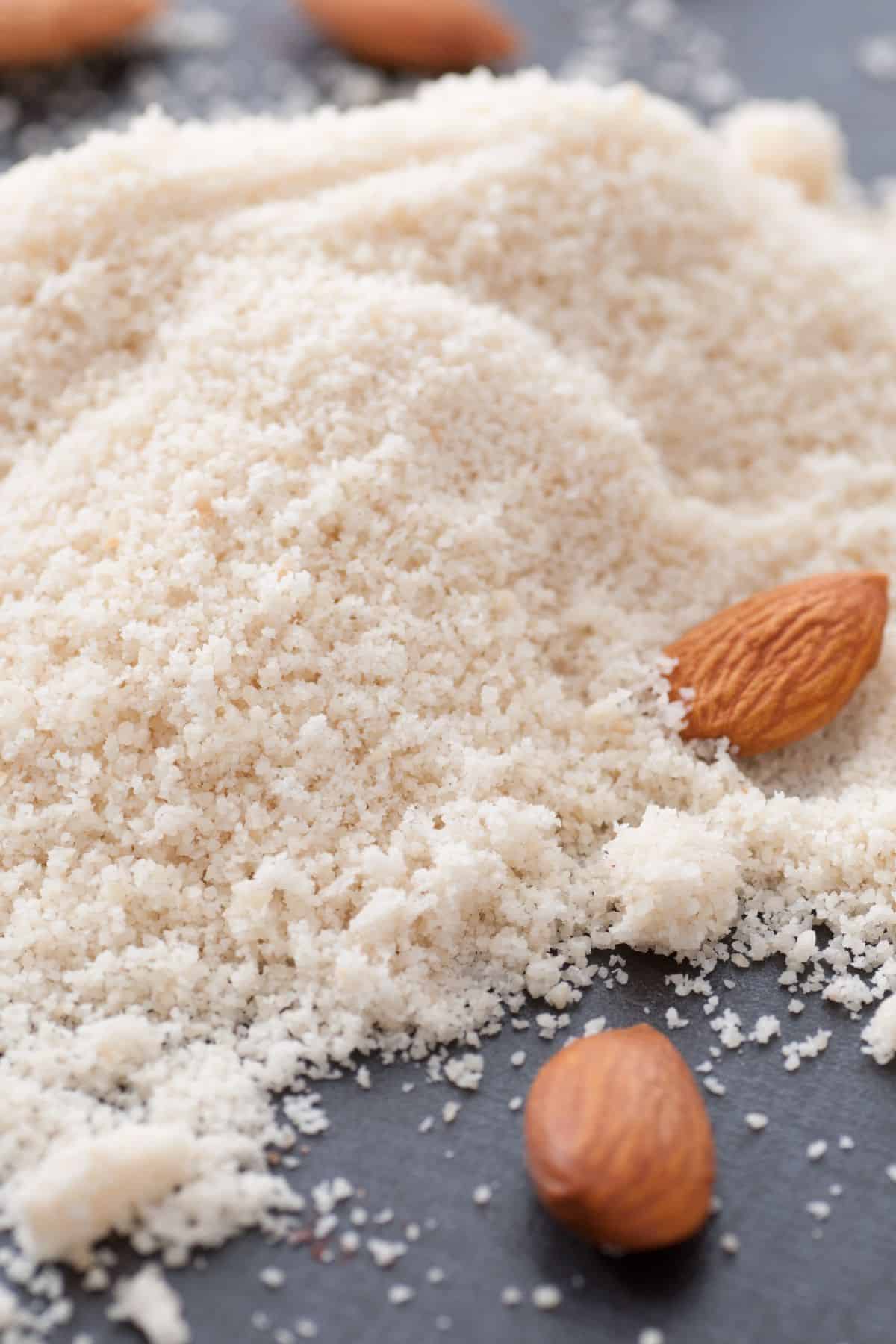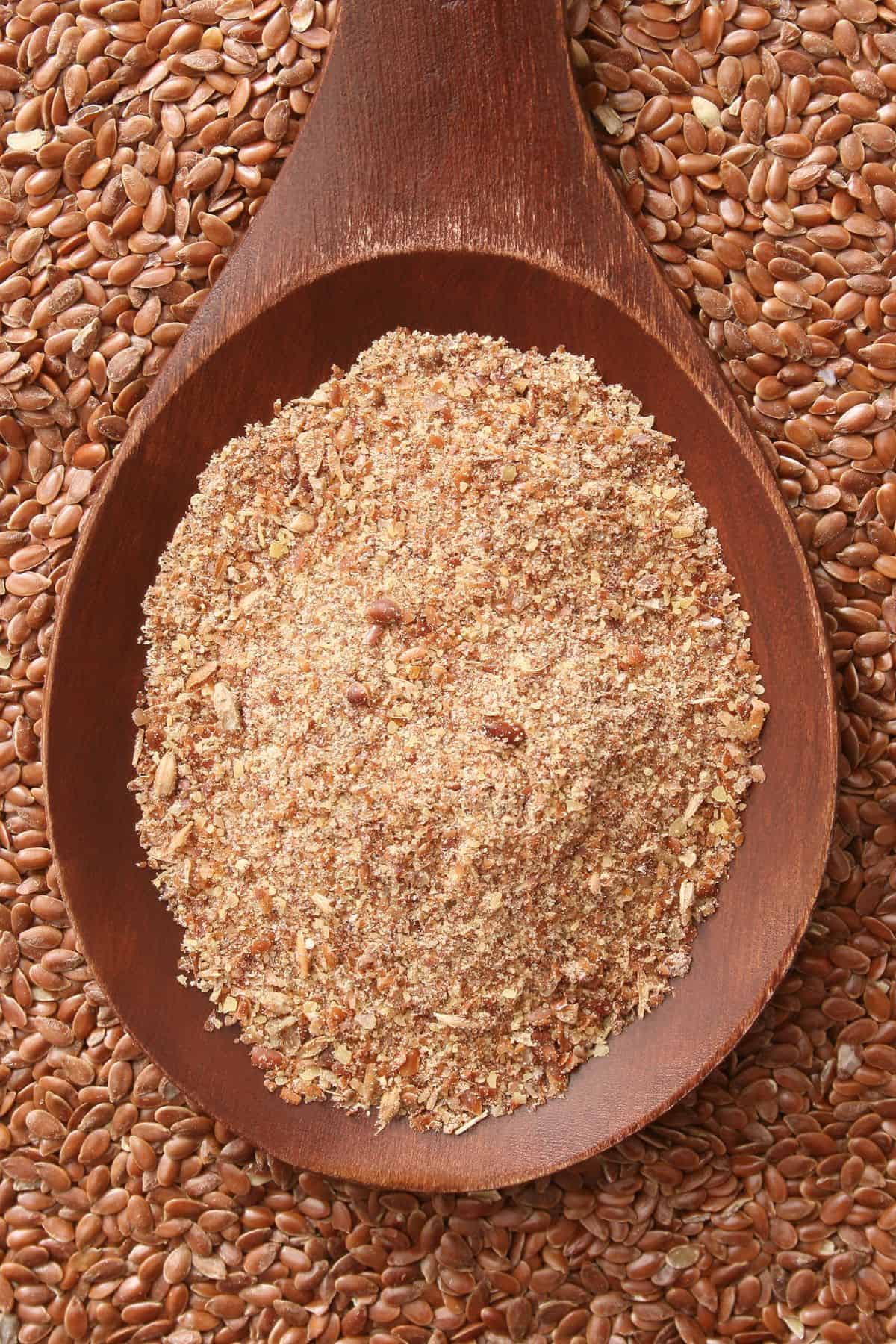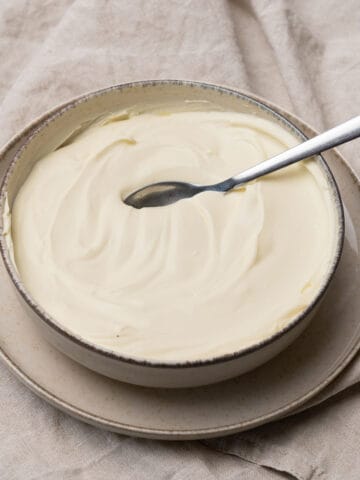There are many reasons why you may need a cornstarch substitute in your next recipe. Perhaps you have a corn allergy or have unexpectedly run out of your stash at home. Or, maybe that delicious recipe you made needs a little thickening, but you can't get to the grocery store.
The good news is there are many suitable cornstarch replacements to consider, some of which may already be in your kitchen pantry! In this guide, I talk about each of those replacements and how to use them in baking and cooking.

Jump to:
- What is cornstarch?
- What is cornstarch used for?
- Considerations when replacing cornstarch
- What is the best corn starch substitute?
- 1. All-purpose flour
- 2. Wheat flour
- 3. Almond flour
- 4. Arrowroot powder
- 5. Potato starch
- 6. Rice flour
- 7. Tapioca flour
- 8. Cassava flour
- 9. Ground flaxseeds
- 10. Glucomannan
- 11. Psyllium husk
- 12. Xanthan gum
- 13. Guar gum
- 14. Sorghum Flour
- 15. Alternative thickeners
- Best cornstarch substitute for baking
- Cornstarch Substitute FAQs
- More Substitute Guides
- The BEST Cornstarch Substitute
What is cornstarch?
Cornstarch, sometimes called maize starch, is derived from the corn kernel's endosperm. It is a fine, white, odorless powder, often a staple in kitchens worldwide for cooking and baking purposes.
Please note that cornstarch in the US is the same product as cornflour in the UK. However, cornflour in the US is basically a very finely ground corn meal (that is yellow) so do not confuse it with corn starch which is powdery and white.
What is cornstarch used for?
Cornstarch is a popular ingredient in cooking and baking, often used as a thickening agent. When heated and exposed to moisture, its molecules expand, causing them to swell.
Cornstarch is essential to thickening sweet and savory recipes such as pastry cream, gravy, soups, sauces, casseroles, and marinades. Because it is derived from corn and not wheat, it is a gluten-free thickener.
In addition to thickening recipes, there are many other uses for cornstarch in the kitchen, including enhancing the texture of baked goods, preventing fruit fillings in pies and tarts from becoming too watery eg. in this peach cobbler with pie crust, reducing the moisture in powdered sugar, and adding crispiness to fried foods.

Considerations when replacing cornstarch
There are many available cornstarch substitutes. However, just because they are acceptable substitutes doesn't mean that all of them will work for you or your recipe.
Before choosing a replacement, you will want to consider any food allergies or dietary restrictions since some substitutes may not be suitable. You will also want to consider the appearance you wish to achieve as well as the flavor, as some replacements have a different outcome than cornstarch.
What is the best corn starch substitute?
Cornstarch is a staple in the kitchen for when you want thicky, creamy, or crispy recipes. However, it isn't the only ingredient that does so. Below are 15 cornstarch substitutes and suitable alternatives to consider:
- All-purpose flour
- Wheat flour
- Almond flour
- Arrowroot
- Potato starch
- Rice flour
- Tapioca
- Cassava flour
- Ground flaxseeds
- Glucomannan
- Psyllium husk
- Xanthan gum
- Guar gum
- Sorghum flour
- Alternative thickeners
1. All-purpose flour
All-purpose flour is the most common cornstarch substitute for thickening and is one of the easiest since it is likely already in your pantry. It is also an excellent cornstarch substitute for frying chicken.
All-purpose flour adds more density to recipes, so it may slightly alter the texture of baked goods. It works in most recipes as a substitute such as soups, stews, sauces, puddings, pastry cream.
However, it is not gluten-free, so you will want to consider another alternative if you have gluten sensitivities.

How to use it:
Use all-purpose flour as a substitute for cornstarch in a 2:1 ratio so use twice as much flour as cornstarch you would use.
To avoid ending up with clumps of flour, add liquid to the flour first and whisk out all of the lumps before adding it to the recipe (just as you would with cornstarch).
2. Wheat flour
Wheat flour is another ingredient commonly found in kitchen pantries, especially for baking. It also serves as an easy cornstarch substitute. However, because it is essentially wheat that has been ground into a powder, it may slightly change the flavor of your recipe.
Wheat flour is very similar to all-purpose flour because it has a more opaque, matte appearance than cornstarch's glossy appearance.
Also, like all-purpose flour, wheat flour is not gluten-free and will not be a suitable substitute for anyone with gluten sensitivities.
How to use it:
Substitute wheat flour for cornstarch in a 2:1 ratio. Like all-purpose flour, you must first mix it with water to eliminate clumps and form a paste. It may also be necessary to cook the recipe a little longer to eliminate the raw wheat flavor of the flour.
3. Almond flour
Another great option is to use almond flour instead of cornstarch. Almond flour is made from almonds that have been boiled, ground, and sifted into a fine powder.
Because it comes from ground almonds, it will have a nutty taste and may slightly alter the flavor of your recipe. It is best as a substitute in recipes that pair well with its flavors, such as baked goods, sauces, and hearty stews. It makes a delicious substitute for cornstarch in baking cookies!
Almond flour is also an excellent cornstarch substitute if you have gluten sensitivities. However, you will want to avoid this substitute if you have a nut allergy.
How to use it:
Use almond flour as a substitute for cornstarch in a 1:1 ratio. It does not clump together as easily as all-purpose or wheat flour, so mixing it with water is unnecessary. However, it never hurts to do so!

4. Arrowroot powder
If you want to avoid changing the taste of your recipe, arrowroot powder (also known as arrowroot flour or arrowroot starch) is one of your best cornstarch substitutes. Arrowroot is the dried and ground roots of the Maranta genus of plants. Although the plant is found in tropical regions, you can find arrowroot powder on many grocery store shelves.
You can use arrowroot powder in any recipe that calls for cornstarch and will get a similar result but with more fiber. Since it turns into a clear gel when mixed with water, it is ideal for thickening clear liquids. It is also a perfect cornstarch substitute for stir-fry.
Arrowroot powder is another excellent gluten-free alternative. It is also an ideal keto substitute for cornstarch and for those on a paleo diet.
How to use it:
Use arrowroot powder as a cornstarch substitute in a 2:1 ratio.
5. Potato starch
Potato starch is one of your best bets if you need a vegan substitute for cornstarch. It is made by smashing and drying to release its starch content, then drying them into a powder. Although you may not find potato starch in your local neighborhood grocery stores, you can usually find it in specialty health food stores or online.
Unlike some other substitutes, potato starch has a bland flavor and will not change the taste of your recipe. It is a suitable replacement for any recipe that calls for cornstarch.
Potato starch is another gluten-free, vegan, and Paleo-friendly option to replace cornstarch.
How to use it:
You can easily swap out cornstarch for potato starch in an equal 1:1 exchange. However, potato starch thickens quickly, so adding it very slowly at the end of the cooking process is best. It will also lose its thickening properties if heated for too long, so it is important to cook it sparingly.
6. Rice flour
Rice flour is another vegan-friendly cornstarch substitute made from milled rice. It has a consistency similar to wheat flour and can withstand heat, making it an excellent substitute for dishes that cook or bake for a long time.
Rice flour is an excellent cornstarch replacement in sauces, soups, and gravy. It is also an ideal cornstarch substitute for tofu and fried chicken. It is naturally gluten-free.
How to use it:
Use rice flour as a cornstarch substitution in a 2:1 ratio. Like all-purpose and wheat flour, you must mix it with water before adding it to your recipe.

7. Tapioca flour
Derived from the cassava root in South America, tapioca flour (also known as tapioca starch in the United States) is a processed starch product made by washing and grinding the root into a pulp, filtering out its starchy liquid, and drying it into a powder. Tapioca comes in flour, flakes, and pearls.
While you can use any of its forms as a cornstarch substitute, I recommend tapioca flour to maintain a similar consistency. It is an excellent substitute for cornstarch in pie and other desserts, puddings, and sweet sauces.
Tapioca is another gluten-free alternative.
How to use it:
Use tapioca flour in a 2:1 exchange for cornstarch.
8. Cassava flour
Tapioca flour comes from the cassava plant, so it only makes sense that it is also an excellent cornstarch substitute! Cassava flour is made by grinding the cassava root into a powder without washing it into a pulp.
Flavorwise, cassava flour has a mild taste. You can use it in the same way that you would use tapioca flour as a substitute. It is also a gluten-free and vegan-friendly alternative.
How to use it:
Use cassava flour as a cornstarch substitute in a 2:1 ratio.
9. Ground flaxseeds
Ground flaxseeds are a popular and absorbent "superfood" that creates a thick, jelly-like consistency when combined with water. For that reason, they are an excellent and healthy cornstarch substitute.
Flavorwise, ground flaxseeds have a nutty flavor. They also have a gritty texture, quite different from the smooth texture of cornstarch. Therefore, it is best to use it as a substitute in recipes whose texture or flavor will make little difference.
Ground flaxseeds are naturally gluten-free and are also Paleo and vegan-friendly. They are also packed with fiber. Just make sure to use ground flaxseeds and not whole flaxseeds!
How to use it:
First, mix two tablespoons of ground flaxseeds with ½ tablespoon of water and let it sit until it forms a thick gel. The result will replace approximately one tablespoon of cornstarch.

10. Glucomannan
Made from the roots of the Asian konjac plant, glucomannan is unlikely to be sitting in your kitchen. However, if you can access this super absorbent powder, you have another excellent cornstarch substitute.
When mixed with hot water, glucomannan forms a very thick gel. It has no color or odor and is ideal for thickening liquid recipes such as sauces, stews, and gravies.
Glucomannan is calorie and carb-free, making it an ideal substitute if you are on a low-carb diet. It is also gluten-free and vegan-friendly.
How to use it:
For each tablespoon cornstarch that the recipe calls for, use only ¼ teaspoon of glucomannan powder. Since it thickens at low temperatures, mixing it with cold water before pouring it into your food is best. Doing so will also help it to avoid forming clumps once it touches the hot liquid.
11. Psyllium husk
A popular fiber supplement in many diets, you may have psyllium husk sitting in your cabinet. It is also a popular addition and substitution in baking and is a suitable substitute for cornstarch.
Like ground flaxseeds, psyllium husk expands and turns into a thick gel when combined with water, making it ideal for soups and stews. However, it is unnecessary to convert it to gel before adding it to your dish.
Psyllium husk is a mixture of several ground fibrous plants, making it suitable for vegan and gluten-free diets. It is also a good substitute for low-carb diets.
How to use it:
Since psyllium husk has a much thicker consistency than cornstarch, you only need to use half the amount. For each tablespoon of cornstarch, start with just ½ tablespoon of psyllium husk and add more directly to your recipe as needed.
12. Xanthan gum
Xanthan gum is a lab-produced vegetable gum often in the ingredient list of processed foods. However, it is also an excellent alternative to cornstarch at home due to its thickening power and stabilizing and emulsifying properties! You can typically find it in the baking aisle of your local grocery store or online.
Xantham gum is made by fermenting sugar with the Xanthomonas campestris bacteria. The resulting gel is then dried and turned into a powder for cooking and baking. It is best as a cornstarch substitute in baked goods, soups, and sauces.
It is naturally gluten-free and is also a vegan-friendly alternative to cornstarch. However, some manufacturers may use wheat, corn, soy, or dairy products to produce it, so those with allergies to those foods should avoid it.
It is important to note that Xanthan Gum is a soluble fiber that cannot break down in the body. When consumed in large amounts (more than what you would use as a thickener), it may cause issues for those with gut issues. However, Xanthan Gum is not known to have any long-term adverse effects on the body.
How to use it:
Just a tiny amount of xantham gum can thicken a large amount of liquid. You should start with just ⅛-1/4 of the amount of cornstarch called for in the recipe and then increase as needed. Adding too much xantham gum can cause the liquid to become too slimy.
13. Guar gum
Like xanthan gum, guar gum is a vegetable gum primarily found in processed foods. It comes from the central, starchy endosperm of the Asian guar bean that has been dried and ground into a powder. However, compared to xantham gum, it is a much less expensive option. You can find guar gum in specialty food stores and online retailers.
Guar gum has a flour-like texture and an off-white color and is often used to bind and thicken ingredients in baked goods. It is best as a cornstarch substitute in baked goods, pie fillings, and sauces.
Guar gum is a naturally gluten-free and vegan-friendly alternative.
How to use it:
Like xantham gum, just a little guar gum goes a long way. To substitute guar gum for cornstarch, start with just ⅛ teaspoon in place of each teaspoon of cornstarch. For the best results, use a sifter to remove clumps and add to the dry ingredients of your recipe before mixing in the wet ingredients.
14. Sorghum Flour
Made from ground grains, sorghum flour has a similar consistency to all-purpose flour and is a popular ingredient choice for baking. It also makes a great thickening agent and cornstarch substitute.
Sorghum flour has a mildly sweet flavor and smooth texture, making it a great cornstarch substitute in baked goods. It is also great for creating a crispy breading for fried foods.
Sorghum flour is a popular gluten-free option and is often combined with other gluten-free flour.
How to use it:
Use sorghum flour as a cornstarch substitute in a 2:1 ratio.
15. Alternative thickeners
When the above cornstarch substitutes aren't available, there are also a few alternative ways to thicken your recipe.
If cooking over the stove, you can simmer your meal longer to help evaporate the liquid and thicken your sauce.
Adding sour cream, milk, or plain Greek yogurt has been known to help thicken recipes.
Lastly, pureeing or blending vegetables or fruits can help make tomato-based sauces thicker and pack your recipe with nutrients.
So, what is the BEST substitute?
Choosing just one substitute that beats the others as a cornstarch substitute isn't easy. The replacement you choose boils down to your recipe's needs, taste preferences, and dietary needs. However, all-purpose flour is the most accessible and most popular substitute.
Best cornstarch substitute for baking
Many cornstarch substitutes are great for baking. The easiest cornstarch substitute is all-purpose flour, although it will make your baked goods denser. Other substitutes I recommend for baking are wheat flour, potato starch, rice flour, and almond flour.
Cornstarch Substitute FAQs
They are similar but not the same. Cornstarch is a white powder made from the starchy endosperm of the corn kernel, whereas corn flour is a yellow powder made from dried whole corn kernels. Cornstarch is flavorless and odorless, whereas corn flour is earthy and sweet.
No. Corn meal consists of dried and ground entire corn kernels versus just the endosperm. Cornstarch has a white color and powdery texture, whereas cornmeal has a yellow color and gritty texture.
No. The two are used in entirely different ways and will not work as substitutes for one another.
No. The two have two completely different functions in baking. However, cornstarch is a component of baking powder. Check my baking powder substitute guide for an easy homemade baking powder recipe!
While not the easiest substitute, yes, cornstarch can step in as a substitute for gelatin as it has similar thickening properties. However, gelatin cannot substitute cornstarch.
While cornstarch isn't always used to thicken baked goods, it is used to help provide structure. Therefore it is an essential component, and you should not eliminate it if the recipe calls for it.
More Substitute Guides

The BEST Cornstarch Substitute
Best Cornstarch Substitutes
- 2 teaspoons All-purpose flour
- 2 teaspoons Wheat flour
- 1 teaspoon Potato Starch
- 2 teaspoon Rice Flour
- 1 teaspoon Almond Flour
Instructions
- To replace 1 teaspoon of cornstarch use one of the above options
Note
- Arrowroot
- Tapioca
- Cassava flour
- Ground flaxseeds
- Glucomannan
- Psyllium husk
- Xanthan gum
- Guar gum
- Sorghum flour
- Alternative thickeners






Leave a Reply